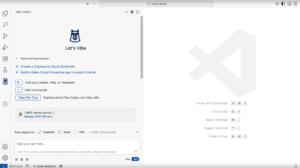
Salesforce today added a vibe coding tool, dubbed Agentforce Vibes, that promises to dramatically accelerate the pace at which enterprise applications can be built and deployed on its platforms.
Agentforce Vibes is an integrated development environment (IDE) specifically created for Salesforce environments that also makes available an autonomous AI agent, christened Vibe Codey, that, for example, generates code suggestions and executes tasks based on the context of the project that has been launched.
It can be integrated into any VS Code-compatible IDE, including Anypoint Code Builder from MuleSoft, Cursor, or Windsurf and is compatible with multiple AI models, including xGen, GPT-5, and Qwen3. In total, more than 20 Model Context Server Protocol (MCP) servers are also supported.
Collectively, this approach to vibecoding makes it possible to rapidly build applications in a way that reuses existing schemas versus relying on third-party tools that will create a new schema and associated metadata for each use case that ultimately becomes unsustainable to manage, says Dan Fernandez, vice president of product for Developer Services at Salesforce.
In effect, Salesforce is now providing citizen and professional developers with an AI coding partner that can plan, build, test, deploy, and observe application development processes, while also automating repetitive tasks. The overall goal is to make it possible to use a vibecoding tool to build high-quality applications that can actually scale, adds Fernandez.
Agentforce Vibes is also designed to be seamlessly integrated with existing low-code tools that Salesforce provides that makes it simpler to mix and match tools based on how complex the application being developed is, notes Fernandez. It is also integrated with the Salesforce Application Lifecycle (ALM) tools such as Salesforce Sandboxes, Code Analyzer v5, and DevOps Center, and with agentic chat capabilities from the Cline open source project.
Application developers can also analyze code, remediate bugs, generate tests, create checkpoints to roll back changes if needed and apply rules and guardrails using the Trust Layer framework that Salesforce has developed for AI applications and agents.
Agentforce Vibes is now generally available with a limited number of requests. Salesforce expects to add a means to more requests along with an ability to use more premium coding models in a future release.
It’s not clear how quickly organizations are adopting vibecoding but the potential for accelerating the pace at which applications are built is profound. In most cases, organizations will initially focus on building greenfield applications that will span everything from departmental workflows to eventually applications that might be deployed corporate wide after they have been fine tuned by professional developers.
Eventually, however, there are entire classes of existing legacy applications based on, for example, spreadsheets that could be replaced by a vibecoding application that provides access to an underlying database.
Regardless of the type of application being developed, the level of collaboration that vibecoding enables should ultimately lead to better applications being built and deployed faster as the pace at which iterations can be created accelerates. In fact, as the cost of updating an application starts to approach zero in the age of AI there may soon come a day when no application is ever truly finished because the next iteration of it that might be deployed is only a few days away from being finalized.


